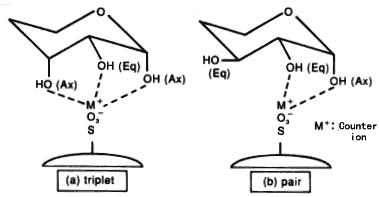General Information on Analysis of Saccharides and Organic Acids
Saccharides
Aqueous SEC (GFC) columns are mainly used for the analysis of saccharides such as starch. However, for the analysis of saccharides in the low molecular weight range with molecular weights similar to each other, GFC mode alone cannot provide satisfactory separation. Shodex columns for saccharides analysis have ligand exchange, ion exchange, ion exclusion, reversed/normal phase and GFC mode combined; these columns are suitable for the analysis of various types of saccharides.
For high-selective analysis of organic acids, affinity chromatography columns, AFpak series columns are recommended.
| Sample Category | Columns to be Selected (SUGAR series) |
|---|---|
| Saccharides contained in ordinary foods | SC1011 |
| Foods containing oligo-saccharides | SC1821, KS-802, KS-802 + SC1011 |
| Dairy products(Sucrose, Lactose, Lactose, Lactulose) | SP0810 |
| Saccharides, organic acids and alcohols in fermented products | SH1011, 1821 |
| Sample containing saccharic acids such as uronic and aldonic | SH1011, 1821 |
| Saccharides in wood and pulp | SP0810 |
The column selection according to monosaccharides, disaccharides, oligosaccharides, polysaccharides, sugar alcohols, organic acids and dietary fibers is shown in this figure.
The column selection according to the analytical conditions to be used is shown in this figure.
| Saccharides to be separated | Columns to be selected |
|---|---|
| Monosaccharides | |
| Glu,Fru | SP0810,SC1011,SC1211,KS-801 |
| Glc,Gal,Fru | SP0810,SC1011,SC1211 |
| Glc,Gal,Man | SP0810 |
| Glc,Gal,Ara | SP0810,SC1011,SZ5532 |
| Glc,Xyl,Ara | SP0810,SC1011,SZ5532 |
| Glc,Fru,Sorbitol | SC1011,SC1211,SC1811,SZ5532 |
| Glc,Gal,Sorbitol,Ducitol | SP0810,SC1011 |
| Glc,Gal,Man,Sorbitol,Ducitol,Mannitol | SP0810 |
| Glc,Fru,Gly,EtOH | SC1011,SC1211,KS-801 |
| Glc,Fru+alcohols | SC1011,SH1011,SC1211 |
| Glc,Fru+organic acids | SH1011,SH1821 |
| Disaccharides | |
| Suc,Lac | SZ5532 |
| Suc,Mal | SZ5532 |
| Suc,Mal,Lac | SZ5532 |
| Mal,Isomaltose | SZ5532 |
| Lac,Lactulose | SP0810,SC1011 |
| Suc,Glc,Fru | SC1011,SC1211,KS-801,SZ5532 |
| Suc,Lac,Glc,Gal,Fru | SZ5532 |
| Mal,Glc,Fru,Gly,EtOH | SC1011,SC1211,KS-801 |
| Cel,Glc,Gal,Man,Xyl,Ara | SP0810 |
| Mal,Glc,Fru,Sorbitol | SP0810,SC1011,SC1211,SZ5532 |
| Mal,Glc,Fru+alcohols | SC1011,SC1211,SH1011 |
| Mal,Glc,Fru+organic acids | SH1011,SH1821 |
| Suc,Glc,Fru,Sorbitol | SP0810,SC1011,SC1211,SC1821 |
| Mal,Maltitol | SP0810,SC1011,SC1211,SZ5532 |
| Suc,Lac,Mal,Maltitol | SZ5532 |
| Glc,Suc,Erythrytol | SP0810,SC1011,KS-801 |
| Mal,Glc,Fru,Erythrytol | SP0810,SC1011 |
| Oligosaccharides | |
| Sta,Raf,Mal,Glc,Gal,Ara | SC1011,KS-801,SZ5532 |
| G4,G3,Mal,Glc | SC1011,KS-801,KS-802 |
| Sta,Raf,Suc,Glc | SC1011,KS-801,SZ5532 |
| Raf,Suc,Glc,Fru,Ara | KS-801 |
| Maltooligosaccharide | SC1821,KS-802,SZ5532 |
| Maltooligosaccharide+alcohols | SC1821,KS-802,SH1821 |
| Maltooligosaccharide+organic acids | SH1821 |
| Maltooligosaccharide+sugar alcohols | SC1821,SC1011+KS-802 |
| Sugar alcohols | |
| Xylitol,Sorbitol | SC1011,SC1211,SZ5532 |
| Sobitol,Mannitol,Xylitol | SP0810,SC1211,SZ5532 |
| Sobitol,Dulcitol,Xylitol | SP0810,SC1011,SZ5532 |
| Maltitol,Sorbitol | SC1011,SC1211,SZ5532 |
| Maltitol,Dulcitol,Arabitol,Xylitol,Mannitol,Sorbitol | SC1211 |
Ara: Arabinose, Cel: Cellbiose, Fru: Fructose, G3: Maltotriose, G4: Maltotetraose, Gal: Galactose, Glc: Glucose, Gly: Glycerol, Lac: Lactose,
Mal: Maltose, Man: Mannose, Raf: Raffinose, Sta: Stachyose, Suc: Sucrose, Xyl: Xylose
Shodex SUGAR series allow the separation of monosaccharides and disaccharides using aqueous eluent under ligand exchange and GFC modes. Basically, saccharides are eluted in order of decreasing molecular weight by GFC mode. The series provides base line stability and linearity over a wide range when quantifying samples, thus permitting the detection of refractive indexes with high sensitivity.
Ligand exchange mode is a separation mode, which employs ion interaction between metal ions (M+) which are the counter ions of the packing material, and hydroxyl (OH–) groups of the saccharides. Saccharides take chair form structure which is energetically stable. Hydroxyl groups are bonded with carbon molecules of chair form and there are two bond types, one is axial(Ax) and another is equatorial(Eq). In the figure above, two cases are illustrated.
(a) Triplet: Three hydroxyl groups having Ax-Eq-Ax structure form a complex with the counter ion. In this case, saccharides are strongly retained by the counter ion.
(b) Pair: Two hydroxyl groups having Ax-Eq structure form a complex with the counter ion. In this case, saccharides are rather strongly reteined by the counter ion but not so strongly as the case of triplet.
In the table below, the numbers of pair and triplet in monosaccharides are shown.
Depending on not only the structure of saccharides but also the type of counter ion, the intensity of interactions applied to the saccharides varies. And, the order of intensity is as follows:
The counter-ion of SUGAR KS-801 packing material is Na+. This column elutes saccharides basically in order of decreasing molecular weights as GFC is the dominant mode of this column. However, the column also can separate monosaccharides from each other to some extent as ligand exchange mode contributes to the separation.
In case of Shodex SUGAR columns, GFC mode, ligand exchange mode and adsorption & partition mode are combined in balance to enable good separation of saccharides.


Organic Acids
RSpak KC-811 is suitable for the analysis of organic acids. KC-811 is packed with strong cation exchange gel (bonded with sulfo groups with coordinated H+ as counter ion) where ion exclusion and reversed phase modes function to separate a variety of organic acids. If it is desirable that reversed phase contribute more to the separation, a reversed phase column RSpak DE-613 or DE-413 can be connected to KC-811. RSpak NN-814 is suitable for the separation of aromatic organic acids under ion exclusion and reversed phase modes.

